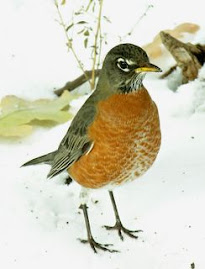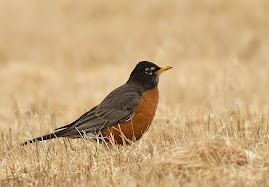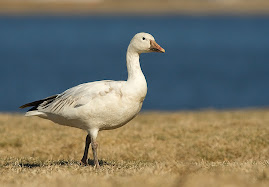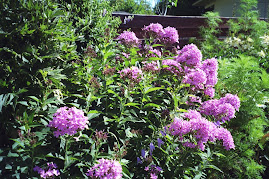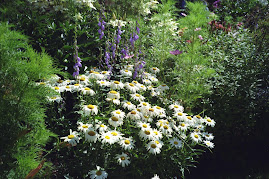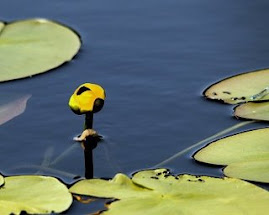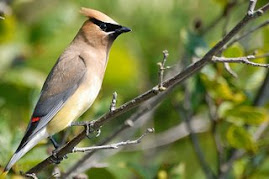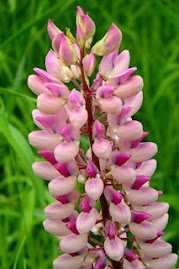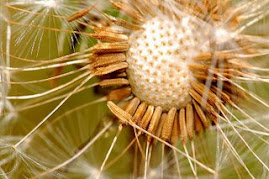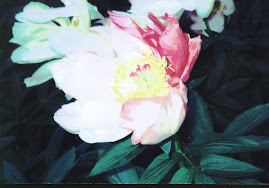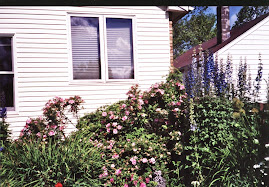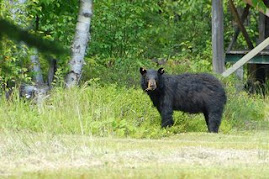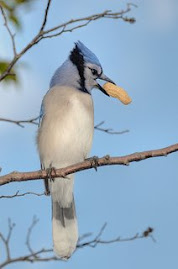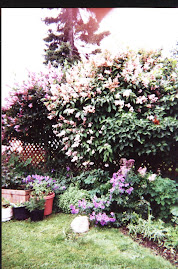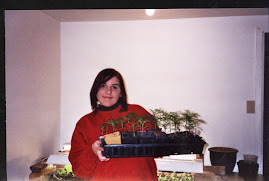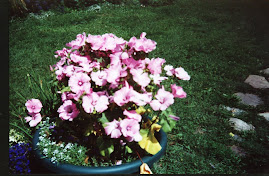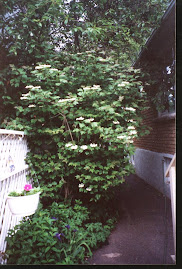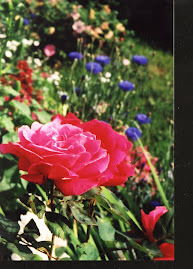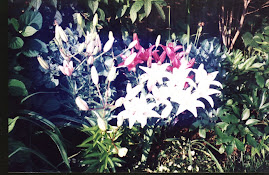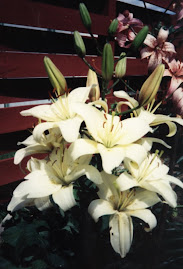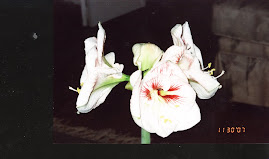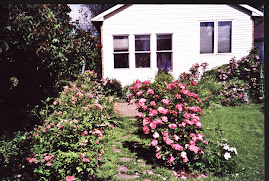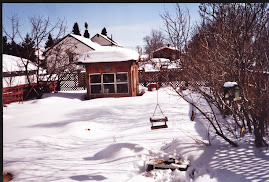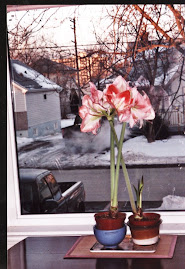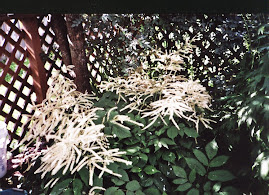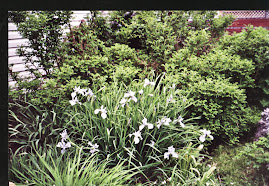The joy of roses. The Morden Snowberry is covered in floppy white blooms, the inestimable Winnipeg Parks is still producing one hot magenta rose after another and the Explorers bring out a few pink blossoms every week. The rose hips will attract birds later in the winter but for now the bright red hips of the Red Leafed Rose are as brilliant as flowers. Around town, many Hansa Roses are still blooming albeit weakly. Their leaves will be the last things to drop with the frost, expected any day now.
This is also PG Hydrangea time. These shrubs are aThunder Bay fav. and every garden should have one just to pick up the spirits this time of year. Many people buy Annabelle hydrangeas with their enormous flower heads but they need winter protection and even so....
My garden is full of birds plus the odd squirrel. I heard that a Thunder Bay guy has been trapping the big black squirrels and releasing them out of town. Is this legal? I hope so. I prefer the tiny native red guys over the muscle bound Toronto newcomers.
There are so many birds around I've set up a fourth bird bath. By far, the birds prefer baths on the ground and they like the blue ceramic saucer the best. Perhaps the colour attracts them. My new bath is a child's snow saucer, purple in colour. I have also bought a device that keeps the water moving in a bird bath. This repels mosquitoes who lay eggs in stagnant water and attracts birds who are attracted to moving water.
I have started to move the bird feeders closer to the house so that they can be seen from the porch window in the winter.
I will also put out the bird bath heater and leave it for a few months. But once it gets really cold (below minus fifteen or so) the heater will not work and the bath freezes solid. Even a kettle of boiling water doesn't do much good.
I have made some high energy seed cakes to put out in the special holders once the frosts sets in. Recipe next post.
Tip: If you believe in prayer, say one to the goddess of gardens for early and deep snow for all northern gardens. Perform a hex to keep away the devil's work - no snow and the mercury deep down in the thermometer's socks.
Showing posts with label roses. Show all posts
Showing posts with label roses. Show all posts
Sunday, 21 September 2008
Saturday, 26 July 2008
WHAT’S IN THE BLOOMING GARDEN?
The time of peonies and roses is past. Cue the lilies and delphiniums.
Perennials. Shasta daisies, white potentilla and the pink Grutendorst rose with its small carnation-style flowers, add lovely side notes. The monk’s hood will bloom in early August with the phlox. I have pulled all the rue which was loaded with seed. It would take over the garden given half a chance but I love its fluffy mauve blooms. I am still finding the odd forget-me-not plant tucked here and there. It gets pulled and composted too.
Lilies. First come the Asiatics, the hardiest of the lilies. My favourite is the early cream -coloured Roma. I also have some good strong yellow Connecticut Kings, reliable and brassy. I do not grow Oriental lilies because they are not hardy but I have a small collection of trumpets which bloom in August. A few years ago, when a neighbour moved, he gave me some lily plants. The blooms are orange with dark brush marks. I believe they are L.A. hybrids. I was a bit taken aback to have the colour orange in my garden, a bit of a clash - but the lilies are so gorgeous I kept them. Five years ago, I dug a clump of lilies near an abandoned farm field. As far as I can tell, they are Asiatics called Pirate. They are tough red guys. I have several other Asiatic cultivars scattered here and there. You can't have too many lilies.
The day lilies will arrive just as the Asiatics are dying down although the small yellow Stella D’oro has a few blooms already. The golden species day lily finished up two weeks ago.
Roses. The roses were marvelous this year. The Morden Snowberry with its flat floppy white flowers, blooms on. It was not attacked by black spot this year although the other Mordens suffered from this nasty leaf disease. Poor Adelaide Hoodless, a Parkland Rose, which barely grows in the dry conditions of my front yard, managed a few bright red blooms. If I could get this rose untangled from the roots of a nearby maple tree, it would do well. But I cannot dig in the rooty soil and so it struggles on. With Heritage, Parkland and Explorer Roses, location is everything. The Bugnet roses have finished a first flush of bloom and should send up repeat flowers later. The Hansa and The roserie de l'Hay will also put out magenta flowers from time to time. Usually I do not dead head roses. I like to leave the rose hips for the birds in the winter. Besides, it would take hours just to dead head the two big Explorers, Jens Munk and William Baffin.
Annuals. Most of the annuals that I grew in my basement last winter are in flower with the exception of the lavatera which is an August bloomer. Bachelor buttons, schizanthus, cosmos and pansies are all out. Strangely, the schizanthus is purple and not pink as in other times but I remember I bought the seeds from a rack because T&T nursery did not offer them this year.
The nicotania (old fashioned fragrant) which was supposed to grow five feet high has started to produce flowers on plants as short as 12 inches. The catalogue promised “an old fashioned fragrance” but I cannot smell a thing. Long ago the scent was bred out of nicotanias and even out of some varieties of sweet pea. I was hoping to discover the famous nicotania scent mentioned in various novels.
Pots. The lobelia (crystal palace) was doing poorly until I gave it good doses of fertilizer. I usually do not fertilize much with commercial fertilizer but rely on my compost and manure. The tiny yellow marigolds (lemon gem), the geraniums (maverick) and the dianthus (raspberry ripple) are crowding the pots.
Flops. The sweet pea is spindly. The nasturtiums, planted in a small window box, were eaten up by an unknown predator although the few seeds I tucked beside the patio grew into fine plants now creeping across the bricks. The godetia, usually a reliable plant, seems to have disappeared entirely.
Veggies. In the back corner, the few vegetables are doing well. The corn, if not as high as an elephant’s eye, is three feet tall and a good looking cucumber entwines it. Zucchini and squash flouish nearby. The tomatoes (early girl) could be bigger and I blame the cool weather and especially the cool nights.
In my dry front yard, the mullein has exceeded expectations by producing a five foot spire loaded with pure yellow flowers. The non-stop begonias are living up to their name. However I planted several bulbs labeled "white" and I am getting many red and a few yellow blooms but no white. Just another garden surprise like the purple schizanthus. The begonia like their window boxes. They are slower to bloom when planted on the ground.
The garden is thick and bushy this year and the warm weather brings out the laziness of the gardener who has a number of good books on hand as well as a good place to read. The weeds are out there, and I’ll get to them after a rain when they are easy to pull. But now, another cup of tea.
Tip. This is a good time to fertilize perennials. Also annuals in pots can be fertilized up to frost.
Perennials. Shasta daisies, white potentilla and the pink Grutendorst rose with its small carnation-style flowers, add lovely side notes. The monk’s hood will bloom in early August with the phlox. I have pulled all the rue which was loaded with seed. It would take over the garden given half a chance but I love its fluffy mauve blooms. I am still finding the odd forget-me-not plant tucked here and there. It gets pulled and composted too.
Lilies. First come the Asiatics, the hardiest of the lilies. My favourite is the early cream -coloured Roma. I also have some good strong yellow Connecticut Kings, reliable and brassy. I do not grow Oriental lilies because they are not hardy but I have a small collection of trumpets which bloom in August. A few years ago, when a neighbour moved, he gave me some lily plants. The blooms are orange with dark brush marks. I believe they are L.A. hybrids. I was a bit taken aback to have the colour orange in my garden, a bit of a clash - but the lilies are so gorgeous I kept them. Five years ago, I dug a clump of lilies near an abandoned farm field. As far as I can tell, they are Asiatics called Pirate. They are tough red guys. I have several other Asiatic cultivars scattered here and there. You can't have too many lilies.
The day lilies will arrive just as the Asiatics are dying down although the small yellow Stella D’oro has a few blooms already. The golden species day lily finished up two weeks ago.
Roses. The roses were marvelous this year. The Morden Snowberry with its flat floppy white flowers, blooms on. It was not attacked by black spot this year although the other Mordens suffered from this nasty leaf disease. Poor Adelaide Hoodless, a Parkland Rose, which barely grows in the dry conditions of my front yard, managed a few bright red blooms. If I could get this rose untangled from the roots of a nearby maple tree, it would do well. But I cannot dig in the rooty soil and so it struggles on. With Heritage, Parkland and Explorer Roses, location is everything. The Bugnet roses have finished a first flush of bloom and should send up repeat flowers later. The Hansa and The roserie de l'Hay will also put out magenta flowers from time to time. Usually I do not dead head roses. I like to leave the rose hips for the birds in the winter. Besides, it would take hours just to dead head the two big Explorers, Jens Munk and William Baffin.
Annuals. Most of the annuals that I grew in my basement last winter are in flower with the exception of the lavatera which is an August bloomer. Bachelor buttons, schizanthus, cosmos and pansies are all out. Strangely, the schizanthus is purple and not pink as in other times but I remember I bought the seeds from a rack because T&T nursery did not offer them this year.
The nicotania (old fashioned fragrant) which was supposed to grow five feet high has started to produce flowers on plants as short as 12 inches. The catalogue promised “an old fashioned fragrance” but I cannot smell a thing. Long ago the scent was bred out of nicotanias and even out of some varieties of sweet pea. I was hoping to discover the famous nicotania scent mentioned in various novels.
Pots. The lobelia (crystal palace) was doing poorly until I gave it good doses of fertilizer. I usually do not fertilize much with commercial fertilizer but rely on my compost and manure. The tiny yellow marigolds (lemon gem), the geraniums (maverick) and the dianthus (raspberry ripple) are crowding the pots.
Flops. The sweet pea is spindly. The nasturtiums, planted in a small window box, were eaten up by an unknown predator although the few seeds I tucked beside the patio grew into fine plants now creeping across the bricks. The godetia, usually a reliable plant, seems to have disappeared entirely.
Veggies. In the back corner, the few vegetables are doing well. The corn, if not as high as an elephant’s eye, is three feet tall and a good looking cucumber entwines it. Zucchini and squash flouish nearby. The tomatoes (early girl) could be bigger and I blame the cool weather and especially the cool nights.
In my dry front yard, the mullein has exceeded expectations by producing a five foot spire loaded with pure yellow flowers. The non-stop begonias are living up to their name. However I planted several bulbs labeled "white" and I am getting many red and a few yellow blooms but no white. Just another garden surprise like the purple schizanthus. The begonia like their window boxes. They are slower to bloom when planted on the ground.
The garden is thick and bushy this year and the warm weather brings out the laziness of the gardener who has a number of good books on hand as well as a good place to read. The weeds are out there, and I’ll get to them after a rain when they are easy to pull. But now, another cup of tea.
Tip. This is a good time to fertilize perennials. Also annuals in pots can be fertilized up to frost.
Tuesday, 8 July 2008
Peony Petals and Rose in Bloom.
The first peony to release its petals is the big Festiva Maxima, one of the greatest of all peonies, a pure white double peony with carmine flecks on the tips of the petals. This is also the first to bloom closely followed by the pale pink Sarah Bernhardt.
I try to cut the peony heads before the petals fall. One bloom releaeses hundreds of petals which stick to the leaves and turn an unattractive brown. On the ground they create an unsightly brown mat. You can tell when the bloom is finished by gently pulling on a petal. It is comes away without effort the head is ready to cut.
I try to cup the blossom in one hand and snip with the other so as to catch as many petals as possible. After I have cut off the old blooms, I brush and shake the plant to get as many petals as possible off the leaves.
The beautiful rose, Winnipeg Parks, is now in full red bloom. The rose was developed at the Morden research Station in Manitoba. (Worth a visit if you are in the province.) It is one of the few tough Canadian roses with long buds like a hybrid tea (which are not hardy here).
My other Parkland Rose is Adelaide Hoodless, named after the founder of the Women’s Institute. This rose struggles to grow in my dry front yard. I wonder if it will even produce a bloom this year. In a better spot, this is a lovely floriferous red rose.
My two Explorer Roses, Jens Munk and William Baffin have burst into pink bloom. These are big bushes, very thorny and covered with blooms in July. They will both continue to produce flowers up to the frost. But they are tough guys to handle. I have to use goat skin gloves to prune them or tie them up. The smaller Explorer, Henry Hudson, seems to like the dry conditions in the front yard and responds with many double white flowers.
The Bugnet Roses are well on their way. I have two Teresa Bugnets, good sized bushes with pink pompom style flowers and a Marie Bugnet, with white blooms. Both are very hardy and need no winter covering. They are considered heritage roses as is the Hazeldean Rose, now sporting double yellow flowers.
My Morden roses did not do well. Winter killed the Morden Snowberry and the Morden Centenial is struggling.
The good old Hansa rose, a Thunder Bay favourite, will bloom from now to frost.
I try to cut the peony heads before the petals fall. One bloom releaeses hundreds of petals which stick to the leaves and turn an unattractive brown. On the ground they create an unsightly brown mat. You can tell when the bloom is finished by gently pulling on a petal. It is comes away without effort the head is ready to cut.
I try to cup the blossom in one hand and snip with the other so as to catch as many petals as possible. After I have cut off the old blooms, I brush and shake the plant to get as many petals as possible off the leaves.
The beautiful rose, Winnipeg Parks, is now in full red bloom. The rose was developed at the Morden research Station in Manitoba. (Worth a visit if you are in the province.) It is one of the few tough Canadian roses with long buds like a hybrid tea (which are not hardy here).
My other Parkland Rose is Adelaide Hoodless, named after the founder of the Women’s Institute. This rose struggles to grow in my dry front yard. I wonder if it will even produce a bloom this year. In a better spot, this is a lovely floriferous red rose.
My two Explorer Roses, Jens Munk and William Baffin have burst into pink bloom. These are big bushes, very thorny and covered with blooms in July. They will both continue to produce flowers up to the frost. But they are tough guys to handle. I have to use goat skin gloves to prune them or tie them up. The smaller Explorer, Henry Hudson, seems to like the dry conditions in the front yard and responds with many double white flowers.
The Bugnet Roses are well on their way. I have two Teresa Bugnets, good sized bushes with pink pompom style flowers and a Marie Bugnet, with white blooms. Both are very hardy and need no winter covering. They are considered heritage roses as is the Hazeldean Rose, now sporting double yellow flowers.
My Morden roses did not do well. Winter killed the Morden Snowberry and the Morden Centenial is struggling.
The good old Hansa rose, a Thunder Bay favourite, will bloom from now to frost.
Tuesday, 15 April 2008
SLEEVE ROSES AND OTHER STUFF
I see the sleeve roses are back at the Home Depot and other places. These roses are encased in cardboard sleeves and the canes are heavily waxed with green wax to prevent sprouting. Most of them are tea or florabunda roses and thus not hardy to this area. Still people buy them and I often wonder if they are disappointed that the plant does not return the next spring. There should be a warning label on the sleeve.
Occasionally you find a hardy rose, such as a Canadian Explorer rose, in the pile. (for a list of hardy roses, watch this space). If you find a hardy rose, you have a bargain because sleeve roses are usually under 10$ while pot roses in the nurseries run 15$ and up.
Sleeve roses take ages to get going in the garden. The wax is heavy and retards the growth. They need a long season.
You can start one now in a large pot if you have a large, warm, indoor space. I have planted them inside the porch in Pro Mix (compost frozen still) and added a handful of Epsom salts, some rose fertilizer and some transplant liquid. I muscle the pot outside about the end of May and they will bloom before the summer ends. I have grown these varieties: Peace, Queen Elizabeth, Mr. Lincoln, Chicago Peace and Iceberg and they all have given excellent results. I put a few pansies and other annuals around the base of the roses.
However, at the end of the season, it is better to toss the rose on the compost. I have managed to carry non-hardy roses over but usually only for one more season and they do not give as much bloom the second year. At one time, I buried non-hardy roses in a four-foot deep trench and dug them up in the spring, alive and sprouting but still slow to bloom.
I have also used rose cones filled with peat moss and mounded up compost around them. (if you use a Styrofoam rose cone be sure to put a brick or rock on top or it will blow away. Also dogs love to chew them up, leaving you with a million styro pellets to pick up in the spring) After that, it all depends on the Thunder Bay winter weather. If we get lots of snow, you may luck out. The next problem is storing the styro cones because, if you put them in a back shed, the mice love them - ah the problems of a gardener!
Spring comes and you remove the protection around the not so hardy roses and stare at them, green stems and brown, mostly brown. What is alive and what is dead? In our climate, some will definitely be dead. Don't leap for the clippers too soon. Unless the stem is broken or damaged, give it a fighting chance, at least until the middle of June. Even a root may send up a sprout.
Some people love the challenge of the non hardy roses but I now stick to the tough guys, the Canadians, who can take the winter.
Occasionally you find a hardy rose, such as a Canadian Explorer rose, in the pile. (for a list of hardy roses, watch this space). If you find a hardy rose, you have a bargain because sleeve roses are usually under 10$ while pot roses in the nurseries run 15$ and up.
Sleeve roses take ages to get going in the garden. The wax is heavy and retards the growth. They need a long season.
You can start one now in a large pot if you have a large, warm, indoor space. I have planted them inside the porch in Pro Mix (compost frozen still) and added a handful of Epsom salts, some rose fertilizer and some transplant liquid. I muscle the pot outside about the end of May and they will bloom before the summer ends. I have grown these varieties: Peace, Queen Elizabeth, Mr. Lincoln, Chicago Peace and Iceberg and they all have given excellent results. I put a few pansies and other annuals around the base of the roses.
However, at the end of the season, it is better to toss the rose on the compost. I have managed to carry non-hardy roses over but usually only for one more season and they do not give as much bloom the second year. At one time, I buried non-hardy roses in a four-foot deep trench and dug them up in the spring, alive and sprouting but still slow to bloom.
I have also used rose cones filled with peat moss and mounded up compost around them. (if you use a Styrofoam rose cone be sure to put a brick or rock on top or it will blow away. Also dogs love to chew them up, leaving you with a million styro pellets to pick up in the spring) After that, it all depends on the Thunder Bay winter weather. If we get lots of snow, you may luck out. The next problem is storing the styro cones because, if you put them in a back shed, the mice love them - ah the problems of a gardener!
Spring comes and you remove the protection around the not so hardy roses and stare at them, green stems and brown, mostly brown. What is alive and what is dead? In our climate, some will definitely be dead. Don't leap for the clippers too soon. Unless the stem is broken or damaged, give it a fighting chance, at least until the middle of June. Even a root may send up a sprout.
Some people love the challenge of the non hardy roses but I now stick to the tough guys, the Canadians, who can take the winter.
Subscribe to:
Posts (Atom)







